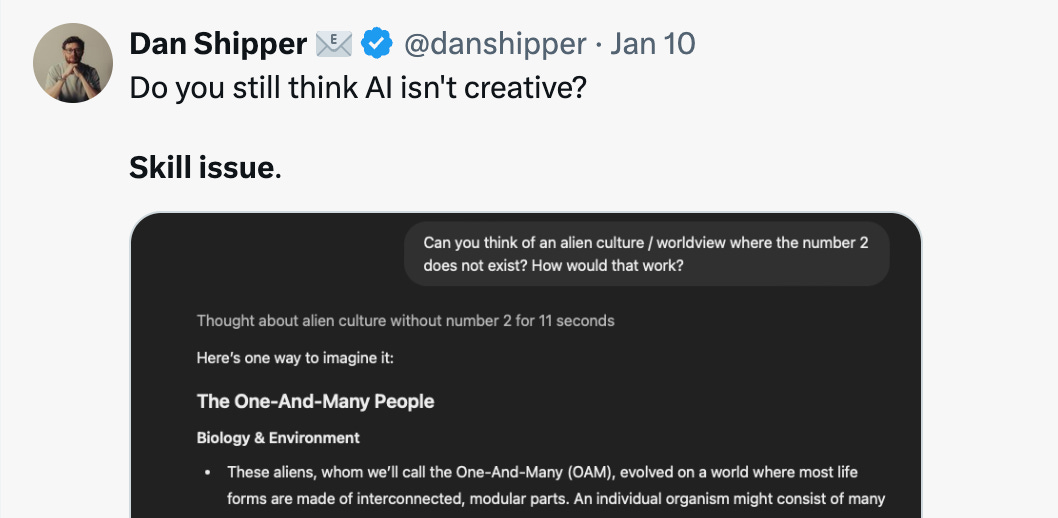Whether you believe we’re on a path to superintelligence or not, it seems likely that the AI we already have will reshape the world around us in short order.
It will do this not by replacing humans outright (as some claim and many fear), but by giving humans who have taste and expertise dramatically more leverage to do more, better, with less. If you know what good looks like, you’ll have an easier time making more of it.
There’s just one problem. Actually three. 1) Good taste is rare. 2) Real expertise is rare. 3) AI capabilities are scaling faster than the adoption of those capabilities (on X this is often expressed as “skill issue”)
It is a skill issue, but that’s not all.
Most people are not feeling the full impact of AI in their day-to-day lives because:
They won’t take the time to master it.
They can’t keep up with the pace of change and what’s possible.
They struggle to imagine all the ways the technology can help them.
Peak AI leverage won’t reach the mass market because most people don’t know what they want. The ability to vibe code any solution in 10 minutes doesn’t change this at all. It just makes it more poignant.
Saying AI will usher in an age of amazing personalized software is like saying people will stop eating out because of better appliances. The problem isn’t the cooking. It’s knowing what to cook, and how to cook it well.
The solution that the frontier AI companies are peddling is: Don’t worry about it—1 we’ll make the chat assistants so smart that they’ll identify and solve your problems for you. They’ll choose the right model, plan the work, and work the plan. And you can get back to your favorite show on Netflix, which is infinity episodes long because the AI is generating more Love Is Blind just for you.
Maybe. 🤔 But this presents a new issue: regression to the mean. AKA averageness. AKA you bitches are ordinary.
Welcome to midwit paradise.
If everyone is having their problems identified and solved by the same three frontier models, the solutions are going to be “average.”
Why? Because AI is an averaging machine. You load in every word ever written, and the training process identifies common patterns and associations. Next token prediction is exactly that—a prediction of what is likely. All prompts being the same, and they often are because humans are lazy (or put more kindly, energy conservative), they tend toward the statistical “center” of their training distribution. This leads to what researchers refer to as “mode collapse.” Blandness. And with reinforcement learning from human feedback, they get even more safe and conventional.
“But, won’t AI at least raise the quality floor?” Sure, what was previously bad (which is a lot) will now be palatable. In some cases, the “new average” output that AI provides will be straight up good enough. But, it won’t help anyone stand out or outperform their competition. At least, not for long. When GPT-6 one-shots all the posts on LinkedIn, which posts will rise to the top? You can’t win an arms race when the arms dealers are giving everyone the same weapons. The floor is raised, but the ceiling is still there, and we’re all squeezed.
You can’t win an arms race when the arms dealers are giving everyone the same weapons.
I want an edge, not an app.
For all these reasons, people and companies will turn to (and pay for) experts and solutions that help them harness AI better than everyone else, without having to do too much work. For highly valuable and scaled problems, these solutions will take the form of complete products.
For the long tail of less valuable or more niche problems though, complete products will not make sense. Think about the number of times a GPT user starts a chat today. Some of those problems belong in a casual chat with an LLM. But a lot of them are valuable enough that they should be solved in a differentiating way.
The problem is, no one is going to pick up 20 additional apps in a single day, much less pay $20/month for each of them. Most of these problems (think: outreach, data enrichment, customer support, content creation, etc.) can be solved without a new interface, simply by automating what needs to happen, with or without a human in the loop.
While white collar workers used to spend their time in docs, spreadsheets, videoconferences, email, presentation software, and just a handful of other interfaces, the true promise of AI is fewer interfaces.2
The best interface is no interface.
Once a month, I need to write an investor update for Plumb. But, I don’t want to pay for premium “investor update” software. That’s gross. No, I simply want AI to read my company’s Slack and send me a great first draft in Notion. However, that’s easier said than done. Should I prompt a frontier model to do this via MCP? Do I even know how to do that? And if I do, how likely is the result to be average?
No, I don’t want that. I want an edge. I want the AI to write the draft the way an S-tier founder would do it. And that means someone needs to encode that taste and expertise into a repeatable workflow. And then, somehow, I need to get access to it. Not one-time access via copy and paste in n8n or Zapier (where my copy and the original start to drift the moment I hit save). No, I need something better.
My apps get updates, why not my workflows?
I want to subscribe to the investor update workflow, and dozens more like it, without additional interfaces or significant expense. I want these workflows to get better and better without me having to worry about them. And I want that improvement to come from human experts who have something the models don’t have: taste and experience.
That’s what I’m working on these days. Not the investor update flow (though I am working on that). Rather, the platform that would enable thousands of flows like that to be shared and regularly updated.
What AI flow would you subscribe to?
All em dashes (—) are my own. Buy my books on Amazon and you’ll see I’ve been doing this since 2011. I’m (one small part of) the reason the models do this shit. Because it’s awesome.




